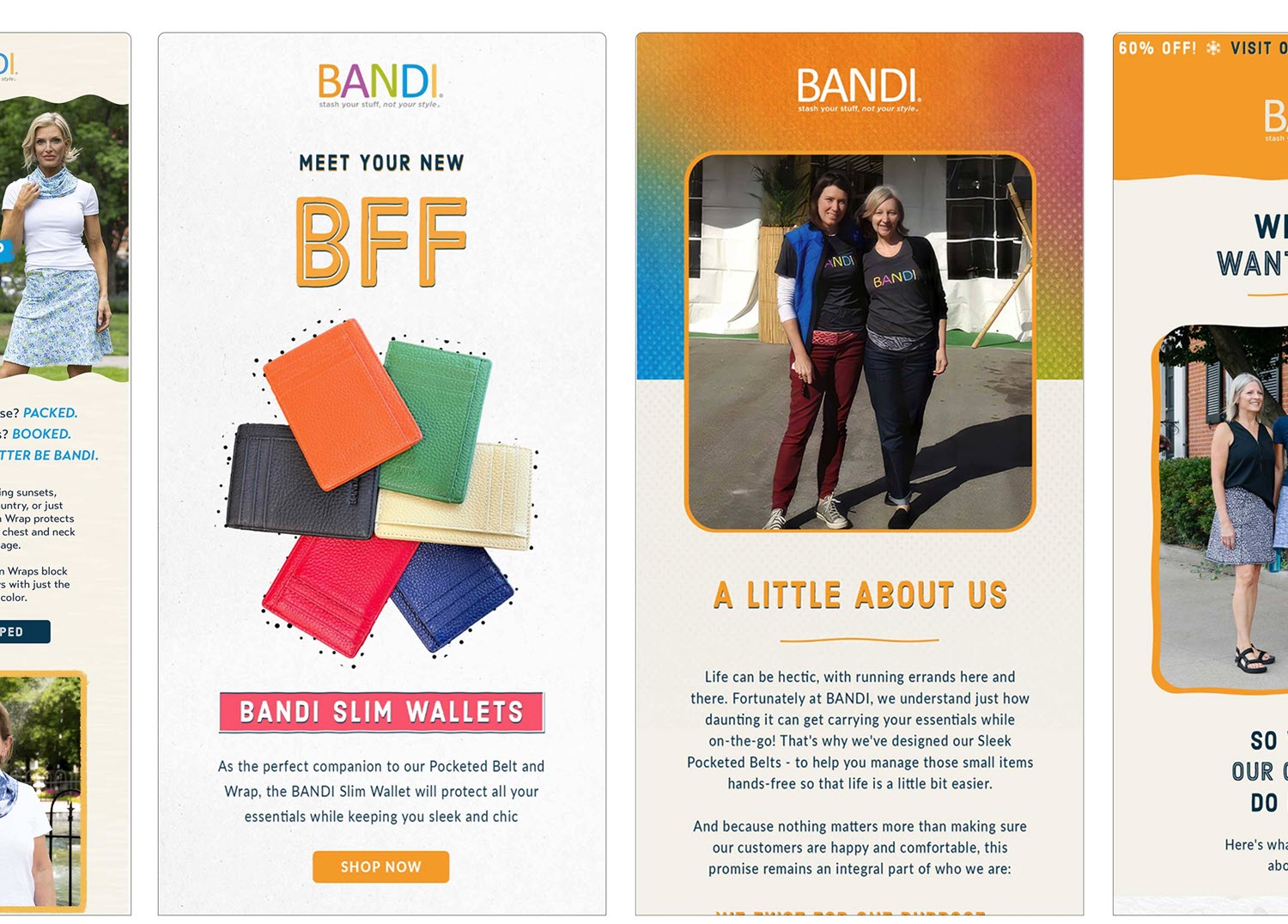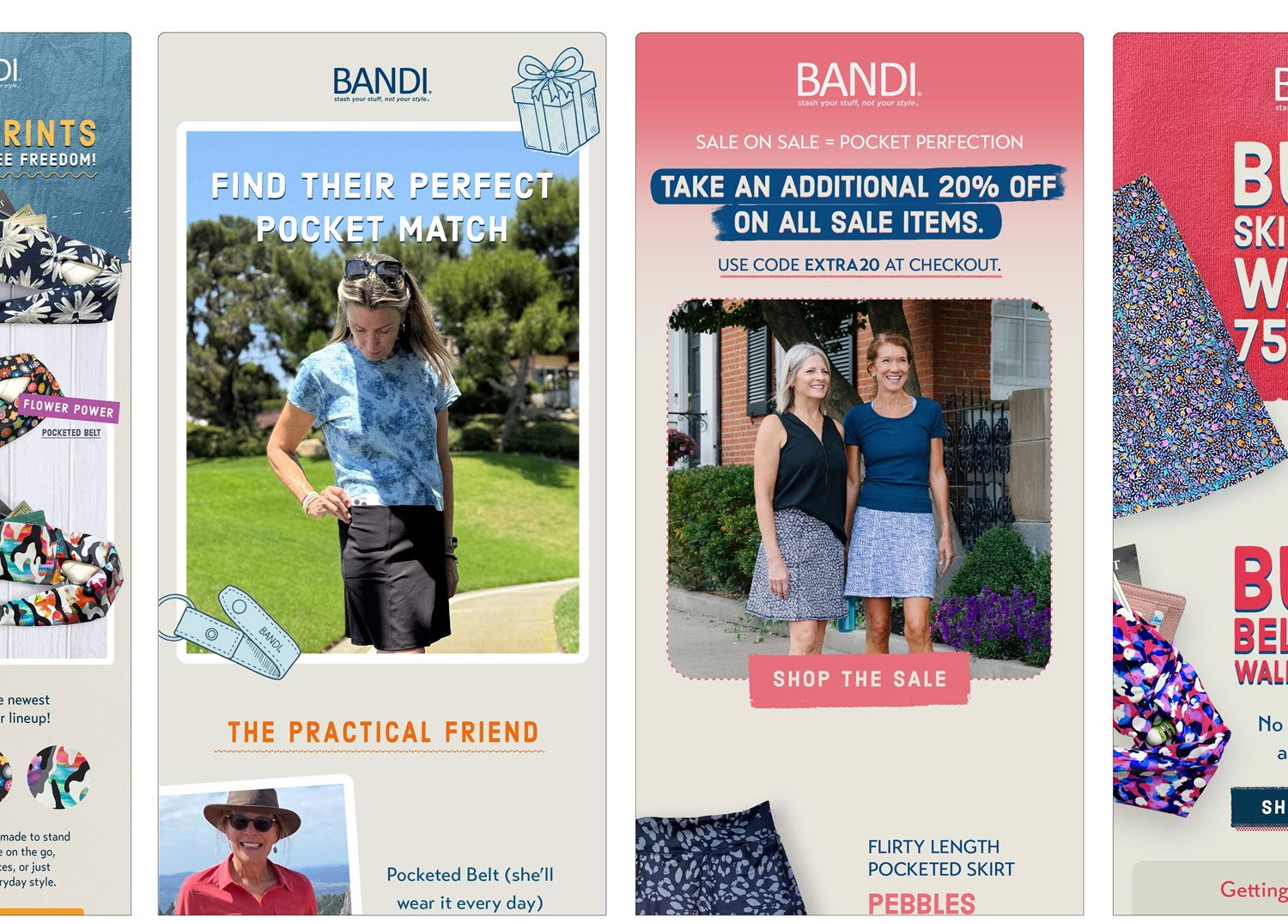Start Growing with asktimmy Today!
get started
Beth Koenig
Founder - BANDI Wear

BANDI Wear makes accessories that actually work for real life. Their functional belts and headbands look great, sure—but more importantly, they solve the "where do I put my phone?" problem for runners, travelers, and anyone who's ever tried to carry things without pockets.
Beth and Bev founded the brand because they needed these products themselves. And their customers? They're active people who value both style and convenience. The kind who'd rather go for a run than sit on the couch, but also care about looking put-together.
When they came to us in October 2022, they were frustrated. Their previous agency had left their email marketing in rough shape. Their email wasn't broken. It just wasn't doing much.
Flows were set up. Campaigns went out. But the numbers were flat. Email was supposed to be this reliable revenue channel, and instead it was just... kind of there.
The founder, Beth, knew something was off. She'd been running the brand for years, had a loyal customer base, great products. But email? It felt like busywork. Send a campaign, get some opens, maybe a few sales. Rinse and repeat.
We looked at what they had and honestly, it was pretty typical of a growing DTC brand. Someone had set up the basics in Klaviyo at some point. Welcome flow, abandoned cart, a few campaigns here and there. Nothing was wrong exactly. It just wasn't strategic.
Here's what we actually did over the next 14 months.

The flows were the obvious place to start because they run 24/7. If they're not working, you're leaving money on the table every single day.
Their welcome series was three emails that basically said "Hey, here's 10% off." No story. No reason to care about BANDI versus any other activewear brand.
So we rewrote it. Told the story of why Beth started the company—making activewear that actually works for real life, not just Instagram. Explained what makes the fabric different. Built some trust before asking for the sale.
Same with abandoned cart. It was just "You left something behind" with a product image. We added social proof, addressed common objections (yes, the pockets really are that good), created some urgency.
We also added flows they didn't have. Browse abandonment to catch people who were clearly interested but didn't add anything to cart. Post-purchase sequences focused on getting that second order, because that's where customers actually become customers.
Nothing fancy. Just thinking through what someone needs to hear at each stage.

This one made a huge difference.
BANDI had customers who'd bought five times and customers who'd browsed once and never came back. They were getting the same emails.
We built segments based on actual behavior. How many times someone's purchased. When they last bought. What they've looked at. How engaged they are with emails.
Then we used those segments. VIP customers got early access to new drops. People who'd bought once six months ago got a different message than people who buy every season. First-time buyers got a series specifically designed to bring them back for purchase two.
It sounds obvious when you say it out loud, but most brands don't do this. They just blast everyone and hope for the best.
Before we started, BANDI would send emails when they had something to announce. New product launch, a sale, Black Friday. That was it.
The problem is, your customers aren't thinking about you in between those moments. If you disappear for weeks at a time, they forget you exist.
We built a calendar. Not aggressive—we're not sending daily—but consistent. A mix of new products, seasonal stuff, and just good content. Tips on how to style pieces, behind-the-scenes with Beth, customer stories.
Over 14 months we sent 81 campaigns. Some did great, some were fine, some we learned from.
For BFCM, we didn't just send emails on Black Friday. We started weeks early. Teased what was coming, warmed people up, built anticipation. By the time the sale hit, people were ready.
This is the part that doesn't sound exciting but actually matters most.
We tested subject lines. Send times. Which products to feature. What kind of offers worked best. Whether urgency or social proof converted better.
Every campaign gave us data. We'd look at what worked, do more of that, and try something new with what didn't.
That's really how you get better at this. You don't figure it all out upfront. You ship something, see what happens, learn, adjust. Month after month.
Email went from "kind of there" to their most consistent revenue channel. Flows that had been averaging $3K/month started doing $15K. Campaign revenue grew steadily. The list became more engaged, not less, even though we were emailing more often.
Beth stopped seeing email as a chore and started seeing it as an actual growth channel.
We're not going to pretend this was some revolutionary approach. It wasn't. We just did the work—strategic work, not just tactical stuff—and kept doing it consistently.
If your email feels like it should be performing better than it is, it probably should. Sometimes it's not about blowing everything up. It's about actually having a strategy behind what you're doing and then executing on it week after week. That's what worked for BANDI. And honestly, it's what works for most brands who stick with it.